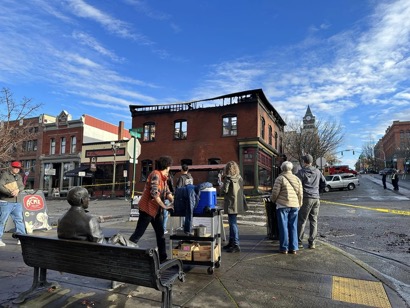Memories of loss
20/12/23 01:50

Individual settlers arrived in the 1840’s and a wave of settlement reached the area in about 1853. The Treaty of Point Elliot was negotiated and signed in 1855 ceding the land where the contemporary city of Bellingham is now located. The treaty is controversial and many claim it was imposed without full disclosure and that promises made orally to local natives were not matched by what was written and that the result of the treaty were different than those agreed to by the tribes seeking to avoid war and bloodshed.
The name Bellingham was given by George Vancouver, who visited the area in 1792. It was named in honor of Sir William Bellingham, who never visited the area.
South of the original Bellingham townsite on the bay the town of Fairhaven was platted. It drew its name from the translation of the Coast Salish name for the bay. See-see-lich-em became safe port became Fairhaven. It was one of several small communities that were later merged into what is now Bellingham.
In the early days of settlement, coal mining and timber cutting were the major activities of settlers. The first Christian church organized in the region was First Congregational Church, organized in 1883. The congregation completed its first building in 1884. A bell, arriving shortly before the building’s dedication traveled around the horn of South America from the east coast of the United States, donated by a New England congregation. That bell became a major player in the story of the community. It served as the community’s fire bell and rallied volunteers to render aid after a major fire devastated the city of Vancouver to the north. The bell also announced the distribution of free meals during the Great Depression. The bell is now in its third building and is still rung by pulling the rope from the steeple each Sunday. My granddaughter and I rang the bell to announce last Sunday’s service in our church.
For some, who have lived in the area for a long time, the sound of the bell on that particular morning, came with a host of bittersweet feelings and memories. Earlier that morning one of the historic buildings, the historic Fairhaven Terminal Building, in the Fairhaven neighborhood of South Bellingham. The building was fully engulfed in flames when firefighters arrived.
Yesterday I was in the neighborhood to do a bit of last-minute shopping across the street from where the now fenced-off remains of the structure are located. The hills are steep in that part of town, reminiscent of the steep hill that volunteers carried the heavy church bell up by hand in order for it to be rung for the first time at the dedication of the church. Small clusters of people gathered on the street to look at the activities of city employees and construction workers seeking to provide temporary shoring to make the building safe for fire inspectors to enter. The whereabouts of the owner of a cafe housed in the building remain unknown and the building is so near to collapse that investigators have not yet been able to enter to search for possible remains.
I am a newcomer to this area. I do not have personal memories of the building which once housed the offices of the mayor of the city. I do not have an attachment to the historic neighborhood where it is located other than the joy of shopping at the large independent bookstore located across the street and at the other end of the block from the burned building. But I could sense the grief of those who had gathered. It was the topic of conversation in the store across the street and mentioned by the clerk who served me.
There have already been posts on social media hoping that the site will not be transferred to developers who might build a modern apartment building in the place of the iconic brick building that housed a cafe, and a separate coffee shop with office above. What to do with the site remains a question for the future. It will be a challenge to make a full inspection of the building. Later it will be a challenge to take it down and move the rubble. The streets are narrow and there will need to be an extended period of lane closures. For now the busted out windows, collapsed roof, and crumbling bricks are a stark reminder of the destructive force of fire. These old buildings were made of heavy timbers milled from nearby trees. Despite a quick response and modern fire fighting equipment including water canons, the building could not be saved. It is beyond repair.
Sensing the grief of long term residents made me think of the grief that must have been experienced by Coast Salish people as they saw the places that had served generations of their people as safe homes, fishing and hunting sites become occupied by settlers who did not know the stories and meanings attached to those places. The invasive and extractive activities of coal miners and timber cutters must have caused great grief for those who had lived for so long with the natural beauty and resources of the area.
Time moves on. Change comes. And now I have become a resident of this area. In years to come, I will be one who can remember before the fire and what the Fairhaven Terminal looked like before it was destroyed. Like people have done for thousands of years, I am collecting the stories of this place.
